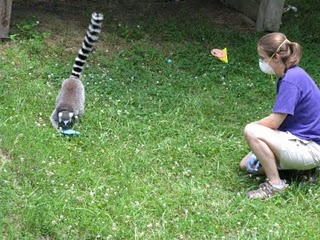EnrichBits: A monthly look at animal enrichment
 Kristen doing some operant conditioning with the ringtail lemurs
Kristen doing some operant conditioning with the ringtail lemurs
Marilyn mentioned operant conditioning in her latest post about Gus the Bear, so I wanted to explain it a bit further.
You can click here for a technical definition of operant conditioning, but it can really be summed up with one word: “training”. Training is the final big area of all those important enrichment categories (remember?…exhibit design, olfactory, visual, auditory, tactile, social, novel objects, and feeding/foraging).
Most zoos use operant conditioning or training programs to ask their animals to perform cued behaviors that help with husbandry, veterinary procedures, and enrichment. For example, I might train a lemur to enter a carrier or crate voluntarily. We use carriers to transfer lemurs from the lemur house to our veterinary exam room in the main museum building. Often, this means chasing and netting the lemur, struggling to get it into the carrier, and creating an unhappy, lengthy (and usually messy!) situation for everyone involved. A lemur’s voluntary crate entry lessens stress and increases efficiency, but also includes a teaching process that is outstanding enrichment, as it requires regular interaction, thought and challenge, novelty, and change. The animal is both mentally and physically stimulated during every training session.
In concept, training is a simple procedure: when the animal does a behavior you want, apply reinforcement (in our case, it’s usually a food treat). In practice, it’s much more nuanced and requires education, learning the motivations and limits of your animals, clear communication, and the daily work of very small steps! Our training program here at the museum is young, and we are guided by a training expert, Julie Grimes, who also works with the keepers at the NC Zoo. We are learning and growing every day, and so are our animals!
Gus the bear is being trained to touch his nose to a target, to present his paws so that our vet can see them, to come into our bear house when asked and to step on the scale– and not move!– so that we can get weights on him quickly and accurately. These are just beginning steps of course; eventually he will be able to voluntarily take an injection into the arm or hip, to open his mouth to get his teeth brushed, and to station at different locations in the exhibit.
It’s really enriching work– for both the animals and keepers!